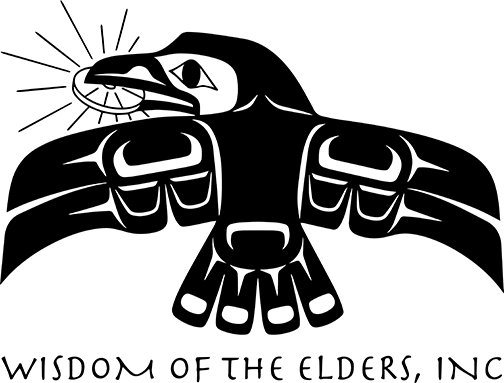Harvest Songs
with Nico Wind
Arlie Neskahi:
And now, in today’s Tribal Rhythms, Nico Wind spreads a feast of songs and dances celebrating the harvest.
Music:
Welcoming Song
Traditional Music From Warm Springs
Canyon Records
Nico Wnd:
Ho ka he! Welcome! It is good to have you here at this celebration of music about native foods – the songs and dances that tell the story of how animals are captured and how plants are gathered and harvested. You are hearing a welcoming song of the native tribes of the northwest. Many tribes would make seasonal trips to the great Columbia River to fish for salmon or trade and visit. They would be greeted and entertained with get-acquainted dances or songs like this one.
Our table is groaning with the weight of many musical dishes we have to serve, telling of fish and poultry; buffalo and venison; beans, squash and, of course, corn. We have many native songs that also sing the virtues of food, of maple sugar, pine nuts, rice and berries. Come and sample just some of the bounty. Come and enjoy!
Music:
Fish Dance
Great Lakes Indians: American Indian Dances
ARC Music
Here is fish! Some native dances simply acknowledge the special traits and beauty of creatures that are enjoyed as food. The Ojibwa Fish Dance features men and women circling clockwise around the singers at the drum. They bend forward and extend both arms back to the right and then flutter their hands in imitation of fins. The song is repeated, each time with a new gesture like jumping or kneeling.
The Laguna Buffalo Dance of the Zuni features both women and men. It is performed in the spring and autumn to bring good luck for hunting by honoring the game.
Music:
Laguna Buffalo Dance
Talking Spirits: Music From the Hopi, Zuni, Laguna and San Juan Pueblos
Music of the World
The men wear shaggy, horned buffalo headdresses. They carry miniature bows and arrows that they thrust forward or wave in a figure-eight motion.
Pine nuts, a staple for the Paiute people and an important part of their culture. They would be delicious sprinkled on fish or venison. The pine nuts are harvested in the fall when people give thanks. In this song, the word tuh van’ means pine nut.
Music:
Judy Trejo
Tuh-van dau ya
Circle Dance Songs of the Paiute and Shoshone
Canyon Records
An Iroquois meal wouldn’t be complete without at least one of the Three Sisters: corn, beans and squash. The sturdy corn stalks support the twining beans, and the shade of the spreading squash vine traps moisture for the growing crop. The well being of each crop is protected by one of the Three Sisters, who, in the Iroquois way, should always be planted together, eaten together and celebrated together.
Music:
Joanne Shenandoah
Three Sisters: Corn, Beans and Squash
All Spirits Sing
Music for Little PeopleMusic:
Corn Grinding Songs
Traditional Navajo Songs
Canyon Records
Wnd:
In Navajo culture, it is the role of the woman to grind the corn for meals. Men would perform a lighthearted song like this to keep the women in good spirits as they worked. You can hear the rhythmic sound of the corn being ground as the women kneel before the grounding stones.
Our cooks are tired! They need a break! The serpent Dance, performed by the Warm Springs women who do the cooking for a feast or celebration, is the answer.
Music:
Serpent Dance
Traditional Music From Warm Springs
Canyon Records
The tired women go out to the dance area, take a man (could be a friend, or even a visitor) and begin dancing with him, forming a line that snakes around the dance floor, mimicking the movements of a serpent. Normally, the man wouldn’t refuse, but if he should, his penalty for refusing could be some item of personal adornment, money or kisses – or even his saddle!
Music:
Jesse Bowman Bruchac
Bean Dance
Songs of the Wabanaki
Good Mind Records
Here are beans! This social song of the Abanaki peoples is one of the many that have always been used for gatherings and celebrations. The central purpose of the music is to bring people together.
Music:
Maple Sugar Song
Great Lakes Indians: American Indian Dances
ARC Music
Something sweet? There’s maple sugar! The Anishanabi people of northern Minnesota rarely used salt. Sugar was the basic seasoning for grains and breads, stew, rice, berries or vegetables. The sugar was made in late March or April, in the moon month of boiling, when the maple sap ran. An Anishanabi song praises the favored seasoning. It says: “maple sugar only satisfies me in the spring.”
Music:
Hopi Butterfly Dance
Talking Spirits: Music From the Hopi, Zuni, Laguna and San Juan Pueblos
Music of the World
The joyful Hopi Butterfly Dance is a traditional social dance. It’s a thanksgiving dance for the harvest in August, chiefly for the corn crop. The Butterfly Dance takes its name from the ancient Hopi custom of young, unmarried women wearing their hair in whorls resembling the wings of butterflies on either side of the head. The men, in velvet shirts with multi-colored ribbons hanging down their backs, shake rattles and dance by lifting their knees high in a springing step.
Music:
Jesse Bowman Bruchac
Closing Song on Flute
Songs of the Wabanaki
Good Mind Records
The plants and animals have been honored with the music and the dances of native people from all directions. We have feasted on their bounty and sampled the variety of their essence. It is good. Pilamaye – thank you!
Host:
Tribal Rhythms is produced by our music director, Nico Wind and written by Anne Morin.
If you’d like to learn more about any of the artists or music featured in our programs, visit us on the web at wisdomoftheelders.org


